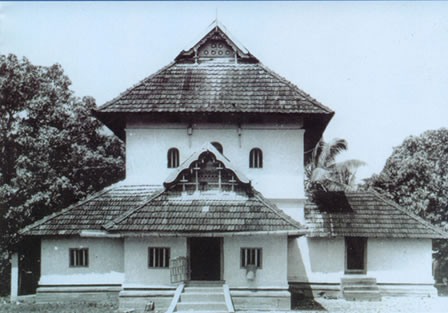

Cheraman Juma Masjid
Origin of Muslims in India
One of the oldest and India’s first masjid, the Cheraman Juma Masjid, lies in Kodungalloor in Kerala. This writer visited the area after the historic tsunami in 2004. As inscribed on the masjid’s stone marker, the mosque was built about 1,400 years ago in 9 Hijra or 629 CE. Kodungalloor was the capital of the ancient kings of Kerala and from 622-628 CE (Hijra 2 to 9) the ruler of the realm was a great savant called Cheraman Perumal Bhaskara Ravi Varma. Cheraman Perumal was the title given to the seniormost of the kingdom’s rulers.
According to some historians, Malik bin Deenar and 12 of his trade associates landed in Kerala and were engaged in trade there. Their way of trading however was distinct from that of earlier Arabs and attracted people beyond mere business relationships.
Hearing of their surprising trade practices, the king had the men brought to his palace to find out more about this. Following inquiries, Malik bin Deenar and his comrades revealed that the reason for their honest trade practices was their recent conversion to Islam. Some say that Deenar was one of the companions of Prophet Muhammad.
Cheraman Perumal asked them more about this Islam which could so radically influence the character and conduct of Arab thugs. The Arabs then described the tenets of Islam and talked to him of their Prophet Muhammad. The king then wanted to know if there was any proof that the person they described was indeed a prophet. The traders described the mujizaat (miracles) performed by the prophet, including the shaqq al-qamar or the splitting of the moon into two.
The king then summoned his astrologers who consulted their almanacs and reported that a phenomenon similar to the one described had in fact been recorded. Cheraman Perumal abdicated his throne forthwith and left with Malik bin Deenar for Arabia where it is chronicled that he met the Prophet Muhammad, accepted Islam and performed the famous last Haj (Hajjatul Wada) with him. On his journey back, he was drowned in a tempest that destroyed his ship. His body came ashore at Salalah in Oman where his grave is a famous landmark even today.
Historian Muhammad Hamidullah writes in Muhammad Rasulullah, quoting from old manuscripts at the India Office Library (Ref No. Arabic, 2607, 152-173, Vol. 16; 06), "There is a very old tradition in Malabar, south-west coast of India, that Chakrawati Farmas (perhaps another name for Cheraman Perumal), one of their kings, had observed the splitting of the moon, the celebrated miracle of the holy prophet at Mecca, and learning on inquiry that there was a prediction of the coming of a messenger of god from Arabia, he appointed his son as regent and set out to meet him."
A tradition of the prophet reported by one of his companions, Abu Saeed Al-Khudri, describes the arrival of Cheraman Perumal: "a king from India presented the messenger of Allah with a bottle of pickle that had ginger in it. The prophet distributed it among his companions. I also received a piece to eat." According to some, Cheraman Perumal took the name Tajuddin after his conversion to Islam while other chroniclers say that he called himself Abdullah Samudri (from the sea) in remembrance of his past.
One Islamic scholar writes that the Kodungalloor mosque was built by the prophet’s followers after they reached Kerala. "The Cheraman Juma Masjid was built by Malik bin Deenar, one of the 13 followers of Prophet Muhammad who reached the ancient port of Musuris (modern Kodungalloor) on the spice route to Malabar in 629 CE."
As such, this masjid was designed and constructed according to principles of Hindu art and architecture. It is situated in Methala village, in Kodungalloor, barely 20 km from the Irinjalakuda railway station in Kerala’s Thrissur district. There are two tombs, that of Malik bin Deenar and his sister, within the masjid premises.
Until 1984 the Cheraman Juma Masjid retained its facade as a typical Kerala structure. In 1984 the local Muslim jamaat, which repaired the building, decided that the new structure should be more like an Islamic shrine with minarets. While retaining the inner configuration of the edifice, the exterior was changed completely. Referring to this, a member of the Indian National Trust for Art and Cultural Heritage reportedly said that in 1984 the trust was formed to protect Indian heritage from such radical alterations. But by 1984 the masjid had been given a new exterior. Otherwise the trust would have appealed and ensured that the 1,400-year-old facade of the structure (although repaired many times) was kept in its pristine grandeur.
Following an exhaustive historical scrutiny, one thing however is certain. Muhammad bin Qasim or Mahmood Ghaznawi were not the originators of the Islamic faith in India; they were only some of the Muslim rulers associated with the rise of Islamic governance in the land. n
Archived from Communalism Combat, May 2008, Year 14, No.131 – Readers Forum
